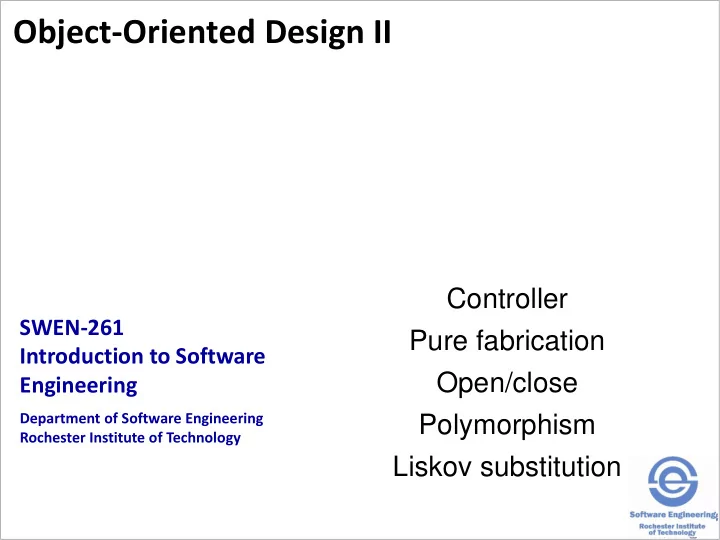

Object-Oriented Design II Controller SWEN-261 Pure fabrication Introduction to Software Open/close Engineering Department of Software Engineering Polymorphism Rochester Institute of Technology Liskov substitution
The lesson continues building your object-oriented design skills with several other design principles. These are also principles from SOLID and GRASP 2
Controller specifies a separation of concerns between the UI tier and other system tiers. Assign responsibility to receive and coordinate a system operation to a class outside of the UI tier. "Controller" is an overused term in software design. • In GRASP, this is not the view "controller" which is firmly in the UI tier. In simple systems, it may be a single object that coordinates all system operations. In more complex systems, it is often multiple objects from different classes each of which handles a small set of closely related operations. 3
Here is how GRASP controllers fit into the software architecture. Simple System More Complex System UI Tier Appl Tier UI Tier Some Appl Tier class Appl Tier Model through these classes through these classes View controllers work View controllers work Operation Subsystem Tier Operation Model Op1 Op3 Tier Op2 Some Model Tier class Where in the sample webapp is there a GRASP-style controller? 4
Pure Fabrication is sometimes needed to balance other design principles. Assign a cohesive set of responsibilities to a non-domain entity in order to support high cohesion and low coupling. Your design should be primarily driven by the problem domain. To maintain a cohesive design you may need to create classes that are not domain entities. In the previous slide, the Operation Subsystem was a pure fabrication. What were pure fabrications in the sample webapp? How could you have implemented it without those fabrications? 5
The Open/closed principle deals with extending and protecting functionality. Software entities should be open for extension, but closed for modification. Software functionality should be extendable without modifying the base functionality. • Mostly provided by features of implementation language: inheritance, interface Your design should consider appropriate use of • Inheritance from abstract classes • Implementation of interfaces Dependency injection provides a mechanism for extending functionality without modification. 6
Polymorphism creates a hierarchy when related behavior varies by class. Assign responsibility for related behavior that varies by class by using polymorphic behavior. Polymorphism is a primary object-oriented concept and should be used whenever possible Bad code smells that indicate a potential class hierarchy and use of polymorphism • Conditional that selects behavior based on a "type" attribute • Use of instanceof or similar language constructs to select operations to perform 7
The Liskov substitution principle constrains the pre- and post-conditions of operations. Objects in a program should be replaceable with instances of their subtypes without altering the correctness of that program Pre-conditions specify what must be true before a method call. Post-conditions specify what will be true after a method call. Design by Contract is a programming technique that requires formal definition of the pre- and post- conditions and has language support for it. 8
Any subclass of a class should be able to substitute for the superclass without error. A subclass must not violate any of the pre- or post-conditions guaranteed by the superclass. Superclass clients count on the pre- and post- conditions being true even when polymorphism has the client interacting with a subclass. To maintain a pre-condition, a subclass must not narrow the pre-condition, i.e. be a subset. To maintain a post-condition, a subclass must not broaden the post-condition, i.e. be a superset. 9
Here is what Liskov substitution allows. mathOp() must accept a param of 1 through 10. It could accept a wider range, i.e. 1 to 15. mathOp() can not quadruple the value of the If client reference is to: parameter because that would lead to a broader post-condition, i.e. return value between 4 and 40. DoMath mathOp() could have a narrower post-condition of Doubler 3 to 17, i.e. it is a PlusTwo class for its full range of input. 10
Recommend
More recommend